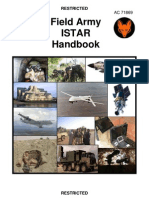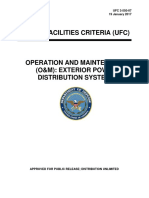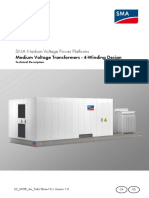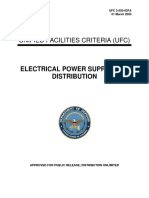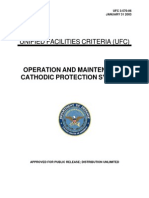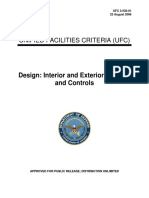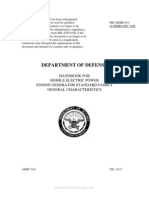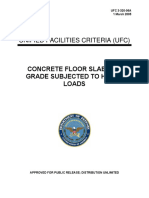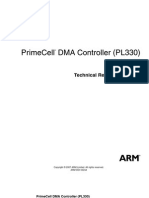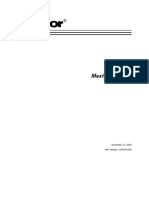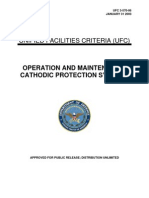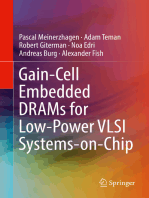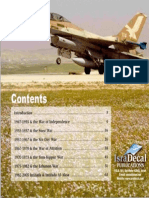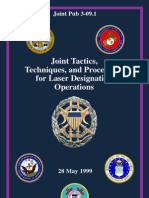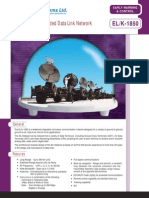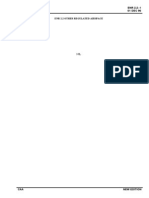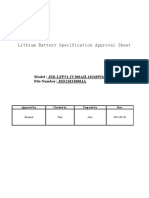N0016411RJQ94 11RJQ94 PerfSpec
N0016411RJQ94 11RJQ94 PerfSpec
Uploaded by
Samar SamerCopyright:
Available Formats
N0016411RJQ94 11RJQ94 PerfSpec
N0016411RJQ94 11RJQ94 PerfSpec
Uploaded by
Samar SamerOriginal Description:
Original Title
Copyright
Available Formats
Share this document
Did you find this document useful?
Is this content inappropriate?
Copyright:
Available Formats
N0016411RJQ94 11RJQ94 PerfSpec
N0016411RJQ94 11RJQ94 PerfSpec
Uploaded by
Samar SamerCopyright:
Available Formats
USMC JTAC LTD
MARCORSYSCOM
29 Sep 2010
PERFORMANCE SPECIFICATION
FOR THE
UNITED STATES MARINE CORPS
JOINT TERMINAL ATTACK CONTROLLER
LASER TARGET DESIGNATOR
(USMC JTAC LTD)
SUBMITTED BY: ___________________ DATE: ___________
Bruce Leaman
Targeting Project Officer
PM Fire Support Systems
Marine Corps Systems Command
APPROVED FOR USE AS
FUNCTIONAL BASELINE BY: ___________________ DATE: ___________
Keith L. Davis
PM Fire Support Systems
Marine Corps Systems Command
AMSC N/A FSC XXXX
Distribution Statement A. Approved for public release; distribution is unlimited.
Comments, suggestions, or questions on this document should be addressed to: MARINE CORPS SYSTEMS COMMAND,
ATTN PM FSS, 2200 Lester Street, Quantico, VA 22134 or emailed to bruce.leaman@usmc.mil. Since contact information
can change, you may want to verify the currency of this address information by using the PM Fire Support Systems Web Site
at http://www.marcorsyscom.usmc.mil/sites/fss/.
1
Table of Contents
1 SCOPE .................................................................................................................................................................. 2
1.1 SCOPE ............................................................................................................................................................. 2
1.2 SYSTEM DESCRIPTION .................................................................................................................................... 2
2 APPLICABLE DOCUMENTS ........................................................................................................................... 2
2.1 GENERAL ........................................................................................................................................................ 2
2.2 GOVERNMENT DOCUMENTS ........................................................................................................................... 2
2.3 ORDER OF PRECEDENCE ................................................................................................................................. 4
3 REQUIREMENTS .............................................................................................................................................. 4
3.1 GENERAL ........................................................................................................................................................ 4
3.2 USMC JTAC LTD COMPONENTS .................................................................................................................. 5
3.3 MISSION PERFORMANCE REQUIREMENTS ....................................................................................................... 8
3.4 WEIGHT ........................................................................................................................................................ 12
3.5 SET-UP TIME ................................................................................................................................................ 13
3.6 SYSTEM SIGNATURE ..................................................................................................................................... 13
3.7 ENVIRONMENTAL REQUIREMENTS ............................................................................................................... 14
3.8 RELIABILITY, AVAILABILITY, MAINTAINABILITY, DURABILITY ................................................................... 17
3.9 SAFETY ......................................................................................................................................................... 17
3.10 MARKING ..................................................................................................................................................... 18
3.11 WORKMANSHIP ............................................................................................................................................ 18
4 VERIFICATION ............................................................................................................................................... 18
4.1 FIRST ARTICLE TESTING ............................................................................................................................... 18
4.2 CLASSIFICATION OF INSPECTIONS ................................................................................................................. 18
4.3 VERIFICATION METHODS.............................................................................................................................. 18
4.4 INSPECTION CONDITIONS .............................................................................................................................. 19
4.5 FIRST ARTICLE INSPECTION .......................................................................................................................... 19
4.6 CONFORMANCE INSPECTION ......................................................................................................................... 19
4.7 RESPONSIBILITY FOR CONFORMANCE........................................................................................................... 19
4.8 GOVERNMENT VERIFICATION OF CONFORMANCE ........................................................................................ 20
4.9 MISSION PERFORMANCE REQUIREMENTS ..................................................................................................... 20
4.10 WEIGHT ........................................................................................................................................................ 21
4.11 SET UP TIME................................................................................................................................................. 21
4.12 SYSTEM SIGNATURE ..................................................................................................................................... 21
4.13 ENVIRONMENTAL REQUIREMENTS ............................................................................................................... 21
4.14 RELIABILITY, AVAILABILITY, MAINTAINABILITY, DURABILITY ................................................................... 23
4.15 SAFETY ......................................................................................................................................................... 23
4.16 MARKING ..................................................................................................................................................... 23
4.17 WORKMANSHIP ............................................................................................................................................ 23
5 PACKAGING .................................................................................................................................................... 23
6 NOTES................................................................................................................................................................ 24
6.1 INTENDED USE ............................................................................................................................................. 24
6.2 ORDERING DATA .......................................................................................................................................... 24
6.3 FIRST ARTICLE ............................................................................................................................................. 24
6.4 DEFINITIONS ................................................................................................................................................. 24
6.5 SUBJECT TERM (KEY WORD) LISTING ........................................................................................................... 25
2
PERFORMANCE SPECIFICATION
USMC JTAC LASER TARGET DESIGNATOR (USMC JTAC LTD)
1 SCOPE
1.1 Scope
This specification establishes performance requirements for the United States Marine
Corps (USMC) Joint Terminal Attack Controller (JTAC) Laser Target Designator (LTD).
1.2 System Description
The USMC JTAC LTD is a lightweight, handheld, man-portable, state-of-the-art laser
target designator/marker that permits warfighters to rapidly bring effective fires to bear on
hostile targets. The USMC JTAC LTD is not intended to replace full power laser target
designators, such as the currently fielded AN/PEQ-17 Portable Lightweight Designator
Rangefinder (PLDR). The USMC JTAC LTD is intended to provide dismounted Marines
with a designation and marking capability that is immediately accessible - i.e. can be worn
in a MOLLE pouch on a flack jacket, or carried in a cargo pocket. The system design
capitalizes on advances in laser generation, and battery power technologies.
2 APPLICABLE DOCUMENTS
2.1 General
The following specifications and standards form a part of this Performance Specification to
the extent specified herein. Unless otherwise specified, the issues of these documents shall
be those listed in the Department of Defense Index of Specification and Standards
(DODISS) as provided from the Defense Standardization Program (DSP) World Wide
Web site at http://www.dsp.dla.mil.
While every effort has been made to ensure the completeness of this list, users of this
document are cautioned that all requirements specified in this document must be met,
whether a reference specification or standard is listed or not.
2.2 Government Documents
2.2.1 Specifications, Standards, and Handbooks
The following specifications, standards, and handbooks form a part of this document to
the extent specified herein.
DEPARTMENT OF DEFENSE STANDARDS
MIL-PRF-49324(NVI) Monocular Night Vision Device AN/PVS-14
Department Of Defense Standards
MIL-STD-130N Identification Marking of U.S. Military Property
MIL-STD-461F Requirements for the Control of Electromagnetic
Interference Characteristics of Subsystems and
Equipment
MIL-STD-810G Environmental Engineering Considerations and
Laboratory Tests
3
MIL-STD-882D Standard Practice for System Safety
MIL-STD-1472F(1) Human Engineering
MIL-STD-1474D(1) Noise Limits
MIL-STD-1913 Dimensioning of Accessory Mounting Rail for
Small Arms Weapons, Dated 03 Feb 1995, with
Change Notice 1 dated 10 June 1999 and Notice of
Validation dated 20 April 2004
MIL-STD-1916 DOD Preferred Methods for Acceptance of Product
MIL-STD-1425A Safety Design Requirements for Military Lasers and
Associated Support Equipment
MIL-STD-2073-1E Standard Practice for Military Packaging
STANAG 3733 Pulse Repetition Frequency Codes
DEPARTMENT OF DEFENSE HANDBOOKS
MIL-HDBK-217F(2) Reliability Prediction of Electronic Equipment
DOD-HDBK-178(1) Quantitative Description of Obscuration Factors for
Electro-Optical and Millimeter Wave Systems
DOD-HDBK-743A Anthropometry of U S Military Personnel (Metric)
MIL-HDBK-783 Chemical and Biological (CB) Contamination
Avoidance and Decontamination
MIL-HDBK-784 Design to Minimize Contamination and to Facilitate
Decontamination of Military Vehicles and Other
Equipment: Interiors and Exteriors
MIL-HDBK-1916 Companion Document to MIL-STD-1916
Copies of these documents are available online at http://assist1.daps.dla.mil/quicksearch/,
http://forms.daps.dla.mil/, http://dodssp.daps.dla.mil, or from the Standardization
Document Order Desk, 700 Robbins Avenue, Building 4D, Philadelphia, PA 19111-
5094.
2.2.2 Other Government Documents, Drawings, and Publications
The following other Government documents, drawings, and publications of the exact
revision level shown form a part of this document to the extent specified herein.
CODE OF FEDERAL REGULATIONS
Title 21, Part 1040 Performance Standards for Light Emitting Products
(Revised 4/1/05)
(Copy of this document available online at
http://www.navsea.navy.mil/nswc/dahlgren/TIE/LASER/federal.aspx)
DEPARTMENT OF THE ARMY
AR 70-38 Research, Development, Test and Evaluation of
Materiel for Extreme Climatic Conditions (15
September 1979 Edition)
4
(Copies of this document are available online at www.apd.army.mil)
DEPARTMENT OF THE NAVY
NAVSEA S9310-AQ-SAF-010 Technical Manual For Batteries, Navy
Lithium Safety Program Responsibilities
and Procedures (20 July 1988 Edition)
OPNAVINST 5100.27B/MCO 5104.1C Navy Laser Safety Hazards Program
Dated 02 May 2008
(Copies of these documents are available online at
http://www.marcorsyscom.usmc.mil/sites/PMEPS/DOCUMENTS/s9310aqsaf010.pdf)
2.2.3 Non-Government Documents
The following documents of the exact revision level shown form a part of this document
to the extent specified herein.
Kollsman Document EICD48151000-1, Electrical Interface Control Document for the
Thermal Laser Spot Imager (TLSI)
Kollsman Drawing MICD48151000-1, Mechanical Interface Control Drawing for the
Thermal Laser Spot Imager (TLSI)
AMERICAN NATIONAL STANDARDS INSTITUTE
ANSI Z136.1 Safe Use of Lasers, dated 2007
(Copies of this document can be ordered online at http://www.ansi.org/ or
http://www.laserinstitute.org/.)
2.3 Order of Precedence
In the event of a conflict between the text of this document and the references cited herein,
the text of this document takes precedence. Nothing in this document, however, supersedes
applicable laws and regulations unless a specific exemption has been obtained.
3 REQUIREMENTS
3.1 General
3.1.1 System Functions
The function of the USMC JTAC LTD is to mark targets for laser handoff to Laser Spot
Trackers (LSTs), and to designate targets by providing terminal guidance to laser-guided
munitions employed by the US Department of Defense (DoD) and North Atlantic Treaty
Organization (NATO) armed forces.
5
3.1.2 Operation
The USMC JTAC LTD shall be capable of being operated by a single 5th through 95th
percentile Marine while wearing any of the full range of Marine Corps combat clothing to
include camouflage utilities, cold and wet weather protective clothing, arctic clothing,
and Mission Oriented Protective Posture (MOPP) Gear - Levels I through IV with no
more than minimal degradation to the users ability to accomplish the mission
(Threshold).
3.1.3 Operating Environment
The USMC JTAC LTD shall be capable of operating in all types of climate and terrain
where Marines deploy (Threshold).
3.1.4 Deployability
The USMC JTAC LTD shall be capable of being carried on all modes of air, land, and
sea transportation and shall be capable of being carried by a Marine during parachute and
swimming (including underwater) operations (Threshold).
3.1.5 Data Integrity
If the USMC JTAC LTD provides data export to meet the objective requirement in
3.3.7.2, it shall be designed to ensure that the integrity of the digital data generated,
processed, and exported by the device is maintained (Threshold).
3.1.6 Design
The USMC JTAC LTD shall meet the Design Requirements of OPNAVINST
5100.27B/MCO 5104.1C Navy Laser Safety Hazards Program (Threshold).
3.1.7 Materials
3.1.7.1 Selection
The contractor shall select materials that meet all of the operational and environmental
requirements specified herein (Threshold). The ability of the system to meet the
applicable performance requirements shall be the governing acceptance standard
(Threshold).
3.1.7.2 Toxic Chemicals, Hazardous Substances, and Ozone-Depleting Chemicals
The use of toxic chemicals, hazardous substances, or ozone depleting chemicals should
be avoided.
3.1.7.3 Recycled, Recovered, or Environmentally Preferable Materials
Recycled, recovered, or environmentally preferable materials shall be used to the
maximum extent possible, provided the materials meet or exceed the operational and
maintenance requirements and promote economically advantageous life cycle costs
(Threshold).
3.2 USMC JTAC LTD Components
3.2.1 Designator/Marker Unit
The USMC JTAC LTD shall emit the following three lasers:
6
1064 nm designator/marker (Threshold)
IR Pointer (Threshold)
Visible Boresight Laser (Threshold)
3.2.2 Tripod
A tripod shall be provided to give users additional support when the operational situation
permits/requires and when used to provide terminal guidance to laser seeking ordnance
(Threshold). The tripod shall weigh less than 3.0 lbs (Threshold), or less than 2.0 lbs
(Objective). The tripod shall be capable of supporting the USMC JTAC LTD alone and
while attached to the Thermal Laser Spot Imager (TLSI) AN/PAS-25 (approx 7.8 lbs)
(Threshold). The tripod shall be adjustable from 16-23 inches in height (Threshold) or 8-
30 inches in height (Objective), and suitable for use by Marines in prone, sitting, and
kneeling positions (Threshold). It is desired that the tripod provide a means for fine
adjustment of azimuth and elevation (pan and tilt) (Objective). The tripod shall not
exceed 18 inches in any dimension when stowed (Threshold).
3.2.3 Remote Firing Cable
The USMC JTAC LTD shall include a Remote Fire Cable (Threshold). When connected
to the USMC JTAC LTD, the Remote Fire Cable shall enable the laser to be fired
remotely (Threshold). The fire button on the Remote Fire Cable shall be a dead-man
button (Threshold). The fire button on the Remote Fire Cable shall be guarded
(Threshold).
3.2.4 Mechanical Interfaces
3.2.4.1 The USMC JTAC LTD shall include at least one Picatinny rail to facilitate mounting
day/night sighting optics/imagers (e.g. ACOG, low profile red dot) (Threshold). The
rail shall be aligned with the emitted laser beams (Threshold).
3.2.4.2 The USMC JTAC LTD shall have the ability to mount to a standard 1/4-20 UNC
threaded tripod (Threshold). The 1/4-20 UNC threaded hole shall be provided as an
adapter that mounts without tools(Threshold), or it may be integrated into the device
near the center of gravity (Objective).
3.2.4.3 A Picatinny rail grabber shall be provided (Threshold). The rail grabber shall be
aligned with the optical path of the emitted lasers (Threshold). The rail grabber shall be
provided as an adapter that mounts to the JTAC LTD without tools (Threshold), or it
may be integrated into the device (Objective).
3.2.5 Protective Optics Covers
The USMC JTAC LTD shall include tethered or hinged covers to protect all lenses and
fully block all emitted laser beams (Threshold).
3.2.6 Battery
The USMC JTAC LTD shall be capable of operating without damage or degradation over
all environments specified within this document when power is provided in accordance
with the following requirements (Threshold):
7
3.2.6.1 The USMC JTAC LTD shall use CR123 batteries, AA batteries, or a rechargeable
battery pack (Threshold). Batteries must be able to be quickly removed and replaced by
users in an operational environment (Threshold). It is desired that the battery
compartment be able to accept a rechargeable battery pack, or a cartridge loaded with
CR123 batteries, or a cartridge loaded with AA batteries (Objective). Any two of the
three will satisfy this objective, although the ability to operate from all three battery
types is desired (Objective). If the USMC JTAC LTD can be powered by a
rechargeable battery pack, three rechargeable battery packs shall be provided with each
system (Threshold). One set of batteries (or one rechargeable battery pack) shall be
capable of meeting the Laser Operational Duty Cycle, Continuous, and Cumulative
Lasing requirements for both the 1064nm and 810-870nm lasers listed in paragraphs
3.3.4.8 - 3.3.4.10 and 3.3.5 (Threshold). If the system is capable of operating from
multiple types of internal batteries/rechargeable battery packs, the vendor may specify
different battery types to be utilized for extreme hot and extreme cold operating
temperatures. It is desired that the device be capable of meeting the full operational
temperature range with one battery type (Objective).
3.2.6.2 The USMC JTAC LTD shall provide an external connection and cable(s) for the
purpose of powering the USMC JTAC LTD (and simultaneously recharging the
rechargeable battery pack if so equipped) from the following electrical sources: BA-
5590, BB-2590, 110 VAC and 220 VAC (Threshold), and 12 and/or 24 VDC Vehicular
Power (Objective). The remote fire switch shall be able to be used while the external
power cable is powering the unit (Threshold).
3.2.6.3 If the USMC JTAC LTD is powered by a rechargeable battery pack, that rechargeable
battery pack shall be able to recharge with 1 each BA-5590 or BB-2590 battery
(Threshold). A rechargeable battery pack shall be able to be 80% charged from these
battery types in less than 2 hours at 20 degrees Celsius, plus or minus 5 degrees, using
the external connection and cable discussed in paragraph 3.2.6.2 above (Threshold).
3.2.7 Transit Case
The USMC JTAC LTD System shall include a transit case that is capable of holding the
complete system (Threshold). It shall be designed to protect all system components from
shock, vibration, abrasion, dust, rain, snow, sleet, and salt spray while the system
components are being transported or stored (Threshold).
3.2.8 Field-Carry Pouch
The USMC JTAC LTD is intended to be a handheld device that is easily carried by a
Marine in combat in such a manner that it is immediately accessible when needed, i.e. in
a Troops-in-Contact situation. A rugged, durable, MOLLE compatible, soft material,
field carry pouch shall be provided (Threshold). The field carry pouch shall fit the
USMC JTAC LTD and one extra set of batteries (or rechargeable battery pack, if so
equipped) (Threshold). The field carry pouch shall fit the USMC JTAC LTD with any
detachable sights that may be provided as part of the system (Threshold). The field carry
pouch shall retain the USMC JTAC LTD securely to the Marines body/equipment while
walking, running, and jumping (Threshold).
3.2.9 Tripod Soft Carry Pouch
8
It is desired that a rugged, durable, MOLLE compatible, soft material, field carry pouch
be provided to carry the tripod (Objective). If provided, it is desired that the tripod field
carry pouch also be able to carry any cables and adapters that are provided with the
system (Objective).
3.3 Mission Performance Requirements
3.3.1 Modes of Operation
The USMC JTAC LTD shall have the following modes of operation:
1064 nm designation/marker laser only (Threshold)
IR Pointer laser only (Threshold)
Visible boresight laser only (Threshold)
1064 nm designation/marker laser and IR Pointer laser simultaneously
(Threshold)
3.3.2 Boresight Error
The boresight error between the center of the 1064 nm laser beam and the aimpoint of the
internal direct or indirect view optic, if so equipped, shall not exceed 0.25 mRad at 20
degrees Celsius, 5 degrees Celsius (Threshold). The boresight error between the center
of the 1064 nm laser beam and the center of the IR Pointer laser beam shall not exceed
0.25 mRad at 20 degrees Celsius, 5 degrees Celsius (Threshold). The boresight error
between the center of the 1064 nm laser beam and the center of the visible laser beam
shall not exceed 0.25 mRad at 20 degrees Celsius, 5 degrees Celsius (Threshold).
The boresight error between the center of the 1064 nm laser beam and the aimpoint of the
internal direct or indirect view optic, if so equipped, shall not exceed 0.5 mRad when
measured over the operational temperature range (Threshold). The boresight error
between the center of the 1064 nm laser beam and the center of the visible laser beam
shall not exceed 0.5 mRad when measured over the operational temperature range
(Threshold). The boresight error between the center of the 1064 nm laser beam and the
center of the IR Pointer laser beam shall not exceed 1.0 mRad (Threshold) or 0.75 mRad
(Objective) when measured over the operational temperature range.
3.3.3 Over-Temperature Shutdown
The USMC JTAC LTD shall detect when an over temperature condition occurs (a
condition that can cause permanent damage to the unit if lasing continues) and warn the
user to override or else lasing will be terminated (Threshold). The over temperature
warning shall be displayed as long as the over temperature condition exists (Threshold).
While in an override state, the USMC JTAC LTD shall continue to lase until the battery
is depleted or until the over-temperature condition causes damage to the device and it is
no longer able to operate (Threshold). It is desired that users be able to enter the override
state without interruption to lasing (Objective).
3.3.4 1064 nm Designation/Marker Laser
The USMC JTAC LTD shall meet all requirements of STANAG 3733 throughout the
temperature range and duty cycle requirements unless specified differently in this
document (Threshold). The emitted 1064 nm laser energy shall be greater than or equal
to 30 milliJoules (mJ) (Threshold), or 50 mJ (Objective).
9
3.3.4.1 Target Designation and Marking
The target shall be a stationary 1.4 x 1.7 meter target (e.g. the front view of a Toyota
Hilux pickup truck) which is placed normal to the laser beam and has a reflectance of
20% at 1064 nm on a standard clear atmospheric day (Threshold). The USMC JTAC
LTD system shall be capable of designating (providing terminal guidance to laser-
guided munitions) a target for all US DoD and NATO laser-seeking precision guided
munitions at 2,000 meters, and marking (effecting a laser hand-off to any US DoD
airborne Laser Spot Tracker (LST)) a target at 3,000 meters (Threshold).
3.3.4.2 Pulse Stability
Within a maximum of 5 seconds after activation, and for the entire Laser Operational
Duty Cycle as defined in paragraph 3.3.4.8, the USMC JTAC LTD shall have an energy
amplitude within +/- 15 percent of the average pulse output energy (Threshold). The
average pulse output energy shall be determined using the arithmetic mean of 120
consecutive pulses.
3.3.4.3 Missed Pulses
The USMC JTAC LTD, operating at any of the pulse repetition rates, shall not miss any
2 pulses in succession (Threshold). The total number of missed pulses shall not exceed
2 over a 60 second period (Threshold). A missed pulse is defined as any pulse that fails
to meet the energy or pulse coding requirements of this specification.
3.3.4.4 Laser Containment
Within 5 seconds after activation, 85 percent (Threshold); 90 percent (Objective) of the
laser energy shall be contained within a stationary 1.4 x 1.7 meter target out to 2,000
meters (Threshold). NOTE: meeting the beam divergence and boresight error threshold
requirements listed elsewhere in this document will not necessarily meet this laser
containment threshold requirement.
3.3.4.5 Beam Divergence
Beam divergence is to be measured as the full angle (in mRad) of a circle that contains
95% of the laser energy. Within 5 seconds after activation, the beam divergence shall
be less than or equal to 0.5 mRad (Threshold). It is desired that the USMC JTAC LTD
have a method whereby the user can quickly adjust the beam divergence from less than
or equal to 0.5 mRad to a value between 0.6 and 1 mRad (Objective).
3.3.4.6 PRF Coding
The USMC JTAC LTD shall transmit at tri-service Band I and Band II PRF codes
(Threshold). The pulse coding and interpulse tolerances shall follow the requirements
described in STANAG 3733 (Threshold). The inter-pulse period specified is the time
increment between the leading edges of successive laser pulses.
3.3.4.7 Pulse Width
The laser output pulse width shall be between 8-25 nanoseconds, measured full width
half maximum (Threshold).
10
3.3.4.8 Laser Operational Duty Cycle
The USMC JTAC LTD shall be capable of being operated at 20 Hz with a duty cycle of
40 seconds on, 30 seconds off (Threshold), 60 seconds on, 10 seconds off (Objective)
over the entire operational temperature range (Threshold). The USMC JTAC LTD shall
be able to sustain this duty cycle continuously until reaching 10 minutes of cumulative
lasing (Threshold), or 20 minutes (Objective). If the system is capable of operating
from multiple types of internal batteries/rechargeable battery packs, the vendor may
specify different battery types to be utilized for extreme hot and extreme cold operating
temperatures. It is desired that the device be capable of meeting the full operational
temperature range with one battery type (Objective).
3.3.4.9 Continuous Lasing
The USMC JTAC LTD, at 20 Hz, shall be capable of 2 minutes of continuous lasing
(Threshold), 5 minutes (Objective) at an ambient air temperature of 20 degrees Celsius.
3.3.4.10 Cumulative Lasing
The USMC JTAC LTD, at 20 Hz, shall be capable of 10 minutes of cumulative lasing
(Threshold), 20 minutes (Objective) per set of batteries (or per one charge of a
rechargeable battery pack, if so equipped) (Threshold).
3.3.5 IR Pointer Laser
The USMC JTAC LTD shall emit an 810-870 nm, 1 Watt laser intended for use as an
infrared (IR) pointer (Threshold). The IR pointer shall be capable of continuous and
pulsed operation with a non-adjustable pinpoint focus only - no flood or illuminator
capability (Threshold). The frequency of pulsed operation shall be 1 Hz (Threshold) or 4
Hz (Objective). The USMC JTAC LTD shall be capable of at least 15 minutes of
cumulative IR Pointer lasing per set of batteries (or per one charge of a rechargeable
battery pack, if so equipped) at -10 degrees Celsius (Threshold). It is desired that the
USMC JTAC LTD be capable of 60 minutes of cumulative IR Pointer lasing per set of
batteries (or per one charge of a rechargeable battery pack) at -15 degrees Celsius
(Objective).
3.3.6 Visible Boresight Laser
The USMC JTAC LTD shall emit a visible laser intended for use as an aid in
boresighting the other two lasers to any of a variety of attachable sights (Threshold). The
visible boresighting laser shall not be a Class 4 laser (Threshold). It is desired that the
visible boresighting laser be a Class 1 laser (Objective). The visible laser shall be
viewable by the operator in bright sunlight at a distance of 10 meters (Threshold).
3.3.7 Sights
3.3.7.1 Mechanical Day Sights
It is desired that if the USMC JTAC LTD does not contain an integrated direct or
indirect view optic that the device have, as a minimum, mechanical sights, commonly
referred to as iron sights, integrated into the body of the device (Objective).
11
3.3.7.2 Attachable/Removable Sights
If the JTAC LTD does not contain an integrated direct or indirect view optic, an
attachable day optic shall be provided (Threshold). It is desired that the magnification
of such optic be of four times magnification or greater (Objective). It is desired that the
reticle be of the mil-scale variety to allow trained users to estimate ranges (Objective).
It is desired that the center of the reticle be an open aiming circle sized to indicate the
beam size of the 1064 nm designation laser at the devices effective operational ranges
(Objective). The USMC JTAC LTD shall be useable in conjunction with the currently
fielded USMC TLSI AN/PAS-25 for its laser spot imaging, as well as observation
capabilities (Threshold). The USMC JTAC LTD shall interface to the Picatinny rail on
the top of the TLSI (Threshold). It is desired that the USMC JTAC LTD communicate
electrically with the TLSI for the purpose of exporting USMC JTAC LTD data for
display by the TLSI (Objective). The type of USMC JTAC LTD information desired to
be displayed by the TLSI is: fault indicators, operational mode, PRF code currently
selected, over temperature warning, low battery warning, etc.
3.3.7.3 Laser Eye Protection
Two sets of DoN approved wearable Laser Eye Protection shall be provided with each
system which are capable of, at a minimum, attenuating laser radiation levels below the
Class I Accessible Emission Limit (AEL) at the aperture for the 1064 nm laser and the
IR Pointer laser contained in the system (Threshold). The Laser Eye Protection shall
also be capable of attenuating laser radiation levels from an 80 mJ 1064 nm laser below
the Class I AEL at the aperture (Threshold).
It is desired that any optics (internal or attachable) provided with the system contain
Laser Eye Protection capable of, at a minimum, attenuating laser radiation levels below
the Class I AEL at the aperture for the 1064 nm laser and the IR Pointer laser contained
in the system (Objective). It is also desired that Laser Eye Protection in the provided
optics also be capable of attenuating laser radiation levels from an 80 mJ 1064 nm laser
below the Class I AEL at the aperture (Objective).
3.3.7.4 Glint Protection
It is desired that the USMC JTAC LTD provide suitable glint protection (Objective).
Any glint protection provided shall not be of a honeycomb type, and shall not obstruct
the path of the emitted lasers (Threshold).
3.3.7.5 Internal Direct or Indirect View Sight
It is desired that the USMC JTAC LTD provide an internal direct or indirect view sight
(Objective). The objective may be met with direct view optics or an indirect view
camera/sensor. If provided, it is desired that the magnification of such sight be of four
times magnification or greater (Objective). It is desired that the reticle be of the mil-
scale variety to allow trained users to estimate ranges (Objective). It is desired that the
center of the reticle be an open aiming circle sized to indicate the beam size of the 1064
nm designation laser at the devices effective operational ranges (Objective). It is
desired that if an internal direct or indirect view sight is provided, that it be factory
boresighted and not require periodic re-alignment by the users (Objective).
3.3.8 System Controls
12
All system controls shall be easily distinguishable and readily accessible when the system
is in any of its operational configurations including, but not limited to, being mounted on
a tripod and while mounted to an AN/PAS-25 TLSI, for Marines wearing combat
clothing identified in 3.1.2 during daylight and night (Threshold).
3.3.8.1 The user shall be able to quickly select any STANAG 3733 PRF code (Threshold).
3.3.9 Display/Visual Indicators
3.3.9.1 Indicators
The USMC JTAC LTD shall provide visual display indicators and all alphanumeric
indicators shall be of sufficient size to be legible by the operator (Threshold). It is
desired that all visual display indicators be evenly illuminated and of a color and
intensity such that they are clearly visible in bright sunlight but do not cause loss of an
operators night vision during periods of low light or darkness (Objective).
3.3.9.1.1 Battery Status
A battery status indicator shall be provided (Threshold). It is desired that the USMC
JTAC LTD provide a battery status indicator to alert the user to a low battery
condition while the user is still able to perform 40 additional seconds of 1064 nm
lasing after receiving the low battery condition alert before being required to change
batteries or connect to an external power source (Objective).
3.3.9.1.2 Fault Indicator
A fault indicator(s) shall be provided that shall illuminate when a condition that can
cause permanent damage to the laser is detected (Threshold). The indicator(s) shall
remain illuminated as long as the fault condition exists (Threshold).
3.3.9.1.3 Information Display
The USMC JTAC LTD shall be capable of displaying information, including PRF
codes, USMC JTAC LTD states, and other information such as fault codes
(Threshold).
3.3.9.1.4 Over Temperature
An over temperature indicator shall be provided which will illuminate when the
designator reaches the threshold of potential high temperature damage (Threshold). It
is desired that the indicator remain illuminated as long as the over temperature
condition exists (Objective).
3.3.9.1.5 BIT/Display Test
It is desired that the USMC JTAC LTD have a test capability of the display segments
and a Built-In-Test capability (Objective).
3.4 Weight
If the USMC JTAC LTD does not contain an integrated direct or indirect view optic, the
device shall not weigh more than 3.5 lbs (Threshold); 2.5 lbs (Objective). If the USMC
JTAC LTD does contain an integrated direct or indirect view optic, the device shall not
weigh more than 4.0 lbs (Threshold), 3.5 lbs (Objective). These weights include the
13
USMC JTAC LTD, one set of batteries (or rechargeable battery pack if so equipped), lens
covers, and anything that is permanently attached to the USMC JTAC LTD (i.e. rails, rail
grabber, connectors, caps, and similar items). The weight of other system components is
not included (i.e. external power cable, field carry pouch, tripod, any removable sights
which may be provided, additional batteries, etc).
3.5 Set-Up Time
The desired total time from removal from field carry pouch to begin designation or
marking is 12 seconds (Objective).
3.6 System Signature
3.6.1 Audible Detection
It is desired that the USMC JTAC LTD not emit noise detectable to the unaided ear at a
range greater than or equal to 20 meters during operation (Objective).
3.6.2 Stray Light Security Displays and Indicators
A method shall be provided that allows the operator to adjust the brightness of all
illuminated indicators to minimize detection (Threshold). It is desired that the USMC
JTAC LTD not be visible (displays, indicators) at ranges greater than 20 meters to
unaided viewing or when viewing with 3rd generation NVGs (Objective).
3.6.3 Stray Light Security Emissions
As an objective for night time use, the USMC JTAC LTD stray light emissions should
not be visible to the naked eye at a distance of 25 meters or greater with any external
displays disabled, and with the system operating in any mode and at any PRF code
(Objective). When using night vision goggles, stray light emissions shall not be visible
(excluding the IR pointer laser) at radial distances that are greater than or equal to 25
meters from the USMC JTAC LTD and that are outside a 5 degree (Threshold), 2 degree
(Objective), cone that is centered on the optical axis of the transmitter (see Figures 1 and
2) and outside a 5 degree (Threshold), 2 degree (Objective), cone that is centered on the
optical axis of the sighting telescope (if so equipped) (Threshold). Using Figures 1 and 2
as a guide, this means that no stray light emissions shall be visible in the crosshatched
areas (Threshold).
The following conditions apply to this requirement:
Night Vision Goggles: unity magnification goggle
Illumination: 1x10
-4
lux (overcast starlight)
Visibility: visual range shall be 20 kilometers
14
3.7 Environmental Requirements
3.7.1 Chemical, Biological, Radiological, and Nuclear (CBRN) Decontamination
It is desired that the USMC JTAC LTD be able to withstand, with limited operational
degradation, at least 4 exposures to the material-damaging effects of NBC contaminants,
decontaminants, and decontaminating procedures in a 72-hour period (Objective). MIL-
HDBK-783 and MIL-HDBK-784 may be referred to for guidance. NOTE: Removing
and discarding external covering materials to meet this requirement is acceptable
provided the procedure to do so can be performed by the operator in a tactical
environment and that the functionality of the USMC JTAC LTD is not degraded by the
removal of the covering material.
3.7.2 Military Free Fall Operations Altitude (Non-operational)
It is desired that the USMC JTAC LTD not suffer any damage or degradation in
performance (as a result of atmospheric pressure related effects) after being subjected to a
military free fall operation conducted from 7,620 m (25,000 ft) Mean Sea Level (MSL) at
an altitude change rate of 8 m/s to 10 m/s (26 ft/s to 33 ft/s) for a period of 1 hour
(Objective). [NOTE: The USMC JTAC LTD shall not require a protective/storage case
to meet this objective requirement; however, use of a field-carry pack is acceptable.]
3.7.3 Immersion (10.0 m)
15
The USMC JTAC LTD shall not suffer any damage or degradation in performance
following a 30-minute submersion in water at a depth of 10.0 m (32.8 ft) while sealed in
a waterproof bag after being conditioned for 2 hours at 10 degrees Celsius above the
water temperature (Threshold).
3.7.4 Immersion (1.0 m)
The USMC JTAC LTD shall not suffer any damage or degradation in performance
following a 10-minute submersion unprotected in fresh or salt water at a depth of 1.0 m
(3.3 ft) after being conditioned for 2 hours at 10 degrees Celsius above the water
temperature (Threshold).
3.7.5 Humidity
The USMC JTAC LTD shall be able to survive up to 100% humidity in accordance with
MIL-STD-810G, Method 507.5, Procedure II (Threshold).
3.7.6 Operating Temperature
The USMC JTAC LTD shall be capable of operating in air temperatures ranging from
negative 10 degrees Celsius to positive 50 degrees Celsius without the benefit of
protective cover or sheltering enclosure for 60 minutes at each temperature (Threshold).
It is desired that the USMC JTAC LTD operate without damage or degradation during
exposure to temperatures of negative 40 degrees Celsius to positive 50 degrees Celsius
without the benefit of protective cover or sheltering enclosure for 60 minutes at each
temperature (Objective).
3.7.7 Storage Temperature
The USMC JTAC LTD shall be capable of being stored in temperatures ranging from
negative 40 degrees Celsius to positive 70 degrees Celsius without the benefit of
protective cover or sheltering enclosure for 60 minutes at each temperature (Threshold).
3.7.8 Temperature Shock
The USMC JTAC LTD shall not suffer any damage or degradation in performance
following sudden changes in ambient air temperature of up to 2 degrees Celsius per
minute (Threshold), or 10 degrees Celsius per minute (Objective), between ambient air
temperatures of -10C and + 50C for a period of two hours at each temperature.
3.7.9 Fungus
It is desired that the USMC JTAC LTD (free of all salt residues) neither support fungal
growth nor suffer damage or degradation of performance caused by the presence of
fungus spores or adjacent fungal growth (Objective).
3.7.10 Mechanical Vibration
The USMC JTAC LTD, within its transit case, shall be able to withstand the vibration
effects experienced during transport in military aircraft (to include helicopter), cross-
country (off-road) vehicular movement, and maritime transport (Threshold). The USMC
JTAC LTD shall be subjected to MIL-STD-810G, Method 514.6, Procedure I, General
Vibration (Threshold). Random vibration levels shall be as identified in figure 514.5C-
17 of Annex C (General Minimum Integrity Exposure), with a test duration of one hour
16
for each of three orthogonal axes (Threshold). Inspect for damage and verify system
operation after completion of testing.
3.7.11 Transportation Vibration (Loose Cargo)
The USMC JTAC LTD shall operate without damage or degradation following exposure,
while in its transit case, to transportation vibration in accordance with MIL-STD-810G,
Method 514.6, Procedure II, Category 5 (Threshold). The total test time shall be three
hours (Threshold).
3.7.12 Transit Drop
The USMC JTAC LTD shall not be damaged or degraded in performance after
experiencing mechanical shocks commonly induced during operations such as entering
and exiting vehicles, running and jumping (Threshold). The USMC JTAC LTD in its
Field Carry Pouch should undergo a drop test on all axes from a height of 30 inches on a
1/4 inch polyethylene foam covered 3/4 inch plywood sheet laying flat on concrete. The
device does not have to be on during the test and optics can have a lens cover attached.
The device should be fully operational following this test.
3.7.13 Sand and Dust
The USMC JTAC LTD shall operate without damage or degradation after exposure to
blowing dust as specified in MIL-STD-810G, Method 510.4, Procedure I (Threshold).
The duration for steps 3 and 7 shall be 6 hours, and the air velocity shall be 1,750 feet per
minute (Threshold). Optical surfaces and connectors are to be covered (Threshold). A
degraded finish is permissible. Markings shall still be legible (Threshold).
3.7.14 Salt Fog
The USMC JTAC LTD shall operate without leakage, damage or degradation after
exposure to a salt fog environment as specified in MIL-STD-810G, Method 509.4
(Threshold). The USMC JTAC LTD shall be exposed for two 24-hour periods with a 24-
hour drying time between each exposure (Threshold). Optical surfaces and connectors
shall be covered (Threshold). Equipment shall not be operating during exposure
(Threshold).
3.7.15 Explosive Atmosphere
Authorized operator actions including but not limited to USMC JTAC LTD operation,
system assembly/disassembly, and operator maintenance, checks, and services, shall not
cause ignition of an atmosphere that is heavily laden with fumes from ground vehicles or
aircraft fuels (Threshold).
3.7.16 Electromagnetic Interference/Electromagnetic Vulnerability (EMI/EMV)
In the operational configuration, the USMC JTAC LTD shall be characterized for the
emission requirement of RE102 of MIL-STD-461E (Threshold). It is desired that the
electric field emissions from the USMC JTAC LTD and its associated cabling conform to
the performance requirements specified for RE101, RE102 (2 MHz - 1 GHz, limit for
ground applications), RS101, and RS103 (2 MHz - 18GHz) when tested in accordance
with the test methodology of MIL-STD-461F (Objective). It is desired that the USMC
JTAC LTD and associated cabling be able to withstand electric fields (Objective).
17
3.7.17 Solar Radiation
The USMC JTAC LTD shall not suffer any damage when exposed to solar radiation of
up to 1120 Watts per square meter (Threshold). It is desired that the USMC JTAC LTD
shall be capable of operating in ambient temperature fluctuations from 10 degrees
Celsius to 50 degrees Celsius with exposure to solar radiation of up to 1120 Watts per
square meter (Objective).
3.8 Reliability, Availability, Maintainability, Durability
3.8.1 Mean Time Between Failures (MTBF)
The desired MTBF for the USMC JTAC LTD, is 13 hours of laser on time when
subjected to the laser operational duty cycle listed above (Objective).
3.8.2 Operational Availability
The USMC JTAC LTD shall have an A
o
of 0.95 (threshold) where A
o
is defined as
MTBM/(MTBM+MDT). Mean Time Between Maintenance (MTBM) is the meantime
between maintenance actions (both preventive and corrective); a measure of the
reliability taking into account maintenance policy. Mean Down Time (MDT) is the
average time a system is unavailable for use due to either corrective or preventive
maintenance. Time includes actual repair time and all delay times.
3.8.3 Preventive Maintenance (PM)
The USMC JTAC LTD shall not require PM to be performed more frequently than once
per week while in storage (Threshold). It shall not require more than 15 minutes to
perform PM (Threshold).
3.8.4 Shot Counter/System Use Meter
It is desired that the USMC JTAC LTD provide a method to track usage (Objective). For
example, a shot counter, elapsed time operated log, or other usage indicator.
3.8.5 Boresight and Calibration
It is desired that the USMC JTAC LTD not require a periodic boresight or calibration
(Objective).
3.9 Safety
3.9.1 Navy Lithium Battery Review Board
If the USMC JTAC LTD battery contains Lithium, the system and the battery shall be
capable of meeting all requirements needed for approval by the Navy Lithium Battery
Review Board (Threshold); is already approved (Objective).
3.9.2 Navy Laser Safety Review Board (LSRB)
The USMC JTAC LTD shall be capable of complying with all requirements identified in
OPNAVINST 5100.27B/MCO 5104.1C needed for approval by the LSRB (Threshold); is
already approved (Objective).
3.9.3 Safety Assessment
18
The operation, maintenance, storage, transportation, or disposal of the USMC JTAC LTD
shall not present any hazards that are assessed as more severe than Serious risks as
specified in MIL-STD-882D (Threshold). It is desired that the operation, maintenance,
storage, transportation, or disposal of the USMC JTAC LTD does not present any
hazards that are assessed as more severe than Low risks as specified in MIL-STD-882D
(Objective).
3.10 Marking
3.10.1 Identification and UID
The USMC JTAC LTD shall have a UID-compliant identification plate of corrosion-
resistant material permanently attached to the outside of the system (Threshold). The
identification plate shall be marked in accordance with MIL-STD-130N and shall include
as a minimum human-readable nomenclature and serial number (Threshold). The USMC
JTAC LTD UID shall include warranty information (Threshold). It is desired that the
USMC JTAC LTD also have a human-readable warranty label providing pertinent
warranty information affixed to the unit (Objective).
3.11 Workmanship
Workmanship in the fabrication and assembly of USMC JTAC LTD components shall
comply with best commercial practices (Threshold). The components shall be clean and
free of burrs, sharp edges, unblended radii, surface defects, cracks, chips, dirt, grease
(except where specifically required), rust, foreign matter or any evidence of poor
workmanship that could render the system unsuitable for its intended purpose or that
would affect life, serviceability or appearance (Threshold).
4 VERIFICATION
4.1 First Article Testing
The contractor is responsible for conducting First Article Testing to show compliance with
sections 4.9 through 4.16 of this performance specification. Proof of previous testing, with
government oversight, which satisfies a first article test requirement may be submitted in
lieu of current testing.
4.2 Classification of Inspections
The inspection requirements specified herein are classified as follows:
First article inspection (see 4.5)
Conformance inspection (see 4.6)
4.3 Verification Methods
Methods utilized to accomplish verification include:
4.3.1 Analysis
An element of verification that utilizes established technical or mathematical models or
simulations, algorithms, charts, graphs, circuit diagrams, or other scientific principles and
procedures to provide evidence that stated requirements were met.
19
4.3.2 Demonstration
An element of verification that involves the actual operation of an item to provide
evidence that the required functions were accomplished under specific scenarios. The
item may be instrumented and performance monitored.
4.3.3 Examination
An element of verification that is generally nondestructive and typically includes the use
of sight, hearing, smell, touch, and taste; simple physical manipulation; and mechanical
and electrical gauging and measurement.
4.3.4 Test
An element of verification in which scientific principles and procedures are applied to
determine the properties or functional capabilities of items.
4.4 Inspection Conditions
Unless otherwise specified, all inspections shall be performed in accordance with the
conditions specified in the applicable paragraphs in this specification or applicable
verification methods (Threshold). If inspection conditions are not specified, the inspection
may be performed at any temperature between 18C (64F) and 30C (86F) and at
1.0+0.1 atmosphere of pressure.
4.5 First Article Inspection
The first article inspection shall be performed on a minimum of two systems (Threshold).
The use of a single system as the test articles for the fungus, sand and dust, salt fog,
explosive atmosphere, and electromagnetic interference tests is acceptable. The first
article inspection shall be performed in a sequential order acceptable to the Government
and shall provide objective evidence regarding the fulfillment of the requirements
(Threshold). Disposition of first article sample systems shall be as specified in the contract
or purchase order (Threshold).
4.6 Conformance Inspection
Unless otherwise specified in this document or in the contract or purchase order, the
contractor shall subject all USMC JTAC LTD systems to inspection for conformance to
this specification in accordance with MIL-STD-1916 (Threshold). Contractors that have
an acceptable quality system and proven process controls relevant to the products being
procured using this specification are encouraged to consider submitting an alternate
acceptance method for verifying conformance to this specification. The acceptability of
alternate acceptance methods is dependent upon the existence of a quality system, the
demonstration of its process focus, and the availability of objective evidence of
effectiveness. The contractor developed Acceptance Test Procedure shall be approved by
the Government and revised as necessary (Threshold).
4.7 Responsibility for Conformance
Contractors are required to deliver USMC JTAC LTDs that conform to the requirements of
this specification and the applicable contract or purchase order, and to generate and
maintain sufficient evidence of conformance. Contractors are responsible for establishing
their own manufacturing and process controls to produce results in accordance with the
requirements. Contractors are expected to use recognized prevention practices such as
20
process controls and statistical techniques to reduce or eliminate manufacturing defects.
Absence of any inspection or process control requirement in this specification or in the
contract does not relieve the contractor of responsibility for assuring that all products
submitted to the Government for acceptance conform to all requirements of the contract
and this specification.
4.8 Government Verification of Conformance
The Government reserves the right to verify the conformance of any system offered for
delivery to the requirements of this specification through independent analyses,
inspections, testing, or demonstrations. Deficiencies found by the Government shall be a
cause for rejection of the USMC JTAC LTD until the manufacturer has provided evidence
that the deficiencies have been corrected (Threshold). The manufacturer shall correct all
such deficiencies at no additional cost to the Government (Threshold). The Government
also reserves the right to verify the contractor's implementation of, and adherence to, their
manufacturing and process controls and to witness the contractor's performance of
conformance inspection procedures.
4.9 Mission Performance Requirements
4.9.1 Modes of Operation
The contractor shall verify, through demonstration, the ability of the USMC JTAC LTD
to conform to the requirements specified in 3.3.1 (Threshold).
4.9.2 Boresight Error
The contractor shall verify, through testing, the ability of the USMC JTAC LTD to
conform to the requirements specified in 3.3.2 (Threshold).
4.9.3 Over Temperature Shutdown
The contractor shall verify, through testing, the ability of the USMC JTAC LTD to
conform to the requirements specified in 3.3.3 (Threshold).
4.9.4 1064 nm Designation/Marker Laser
The contractor shall verify, through testing, the ability of the USMC JTAC LTD to
conform to the requirements specified in 3.3.4. through 3.3.4.10 (Threshold).
4.9.5 IR Pointer Laser
The contractor shall verify, through testing, the ability of the USMC JTAC LTD to
conform to the requirements specified in 3.3.5 (Threshold).
4.9.6 Visible Boresight Laser
The contractor shall verify, through testing, the ability of the USMC JTAC LTD to
conform to the requirements specified in 3.3.6 (Threshold).
4.9.7 Sights
The contractor shall verify, through testing and examination, the ability of the USMC
JTAC LTD to conform to the requirements specified in 3.3.7 through 3.3.7.5 (Threshold).
4.9.8 System Controls
21
The contractor shall verify, through demonstration or examination, the ability of the
USMC JTAC LTD to conform to the requirements specified in 3.3.8 through 3.3.8.1
(Threshold).
4.9.9 Display/Visual Indicators
The contractor shall verify, through demonstration or examination, the ability of the
USMC JTAC LTD to conform to the requirements specified in 3.3.9 through 3.3.9.1.5
(Threshold).
4.10 Weight
The contractor shall verify, through examination, the ability of the USMC JTAC LTD to
conform to the requirements specified in 3.4 (Threshold).
4.11 Set Up Time
The contractor shall verify, through demonstration, the ability of the USMC JTAC LTD to
conform to the requirements specified in 3.5 (Threshold).
4.12 System Signature
4.12.1 Audible Detection
The contractor shall verify, through demonstration and testing in accordance with
requirement 2, Table 2-II of MIL-STD-1474D, the ability of the USMC JTAC LTD to
conform to the requirements of 3.6.1 (Threshold).
4.12.2 Stray Light Security
The contractor shall verify, through demonstration or examination, the ability of the
USMC JTAC LTD to conform to the requirements in 3.6.2 and 3.6.3 (Threshold).
4.13 Environmental Requirements
4.13.1 Chemical, Biological, Radiological, and Nuclear (CBRN) Decontamination
The contractor shall verify, through analysis, demonstration or testing, the ability for the
USMC JTAC LTD to conform to the requirements specified in 3.7.1 (Threshold).
4.13.2 Military Free Fall Operations Altitude (Non-operational)
To determine conformance to 3.7.2, the USMC JTAC LTD shall be tested in accordance
with MIL-STD-810G, Method 500.5, Procedure I (Threshold).
4.13.3 Immersion (10.0 m)
To determine conformance to 3.7.3, the USMC JTAC LTD shall be tested in accordance
with MIL-STD-810G, Method 512.5, Procedure I (Threshold).
4.13.4 Immersion (1.0 m)
To determine conformance to 3.7.4, the USMC JTAC LTD shall be tested in accordance
with MIL-STD-810G, Method 512.5, Procedure I (Threshold).
4.13.5 Humidity
22
To determine conformance to 3.7.5, the USMC JTAC LTD shall be tested in accordance
with MIL-STD-810G, Method 507.5, Procedure 2 (Threshold).
4.13.6 Operating Temperature
To determine conformance to 3.7.6, the USMC JTAC LTD shall be tested in accordance
with MIL-STD-810G, Method 501.5, Procedure II (high temperature), and Method 502.5,
Procedure II (low temperature) (Threshold).
4.13.7 Storage Temperature
To determine conformance to 3.7.7, the USMC JTAC LTD shall be tested in accordance
with MIL-STD-810G, Method 501.5, Procedure I (high temperature), and Method 502.5,
Procedure I (low temperature) (Threshold).
4.13.8 Temperature Shock
To determine conformance to 3.7.8, the USMC JTAC LTD shall be tested in accordance
with MIL-STD-810G, Method 503.5, Procedure I-B (Threshold).
4.13.9 Fungus
Conformance of the USMC JTAC LTD to paragraph 3.7.9, shall be proven through
analysis in accordance with MIL-STD-810G, Method 508.6 (Threshold).
4.13.10Mechanical Vibration
To determine conformance to 3.7.10, the USMC JTAC LTD shall be tested in accordance
with MIL-STD-810G, Method 514.6, Procedure I (Threshold).
4.13.11Transportation vibration (Loose Cargo)
To determine conformance to 3.7.11, the USMC JTAC LTD shall be tested in accordance
with MIL-STD-810G, Method 514.6, Procedure II, Category5 (Threshold).
4.13.12Transit Drop
To determine conformance to 3.7.12, the USMC JTAC LTD shall be tested in accordance
with MIL-STD-810G, Method 516.6, Procedure IV, with the exception that the drop
height shall be 30 inches vice 48 inches (Threshold).
4.13.13Sand and Dust
To determine conformance to 3.7.13, the USMC JTAC LTD shall be tested in accordance
with MIL-STD-810G, Method 510.5, Procedure I (Threshold).
4.13.14Salt Fog
To determine conformance with 3.7.14, the USMC JTAC LTD shall be tested in
accordance with MIL-STD-810G, Method 509.5 (Threshold).
4.13.15Explosive Atmosphere
To determine conformance with 3.7.15, the USMC JTAC LTD shall be tested in
accordance with MIL-STD-810G, Method 511.5, Procedure I (Threshold).
4.13.16Electromagnetic Interference (EMI)
23
To determine conformance with 3.7.16, the USMC JTAC LTD shall be tested in
accordance with RE102 of MIL-STD-461F (Threshold).
4.13.17Solar Radiation
To determine conformance with 3.7.17, the USMC JTAC LTD shall be tested in
accordance with MIL-STD-810G, Method 505.5, Procedure I (Threshold).
4.14 Reliability, Availability, Maintainability, Durability
4.14.1 Mean Time Between Failures (MTBF)
The contractor shall verify, through testing or analysis, the ability of the USMC JTAC
LTD to conform to the requirements specified in 3.8.1 (Threshold).
4.14.2 Operational Availability
The contractor shall verify, through analysis and demonstration, the ability of the USMC
JTAC LTD to conform to the requirements specified in 3.8.2 (Threshold).
4.14.3 Preventive Maintenance
The contractor shall verify, through demonstration, the ability of the USMC JTAC LTD
to conform to the requirements specified in 3.8.3 (Threshold).
4.14.4 Shot Counter/System Use Meter
The contractor shall verify, through demonstration, the ability of the USMC JTAC LTD
to conform to the requirements specified in 3.8.4 (Threshold).
4.14.5 Boresight and Calibration
The contractor shall verify, through testing, the ability of the USMC JTAC LTD to
conform to the requirements specified in 3.8.5 (Threshold).
4.15 Safety
The contractor shall verify through a combination of testing, analysis, demonstration and
examination, the ability of the USMC JTAC LTD to conform to the requirements specified
in 3.9 through 3.9.3 (Threshold).
4.16 Marking
The contractor shall verify by examination the ability for the USMC JTAC LTD to
conform to the requirements specified in 3.10 through 3.10.1 (Threshold).
4.17 Workmanship
The contractor shall verify, by examination, the ability of the USMC JTAC LTD to
conform to the requirements specified in 3.11 (Threshold).
5 PACKAGING
Material shall be packaged for entry into the military distribution system in accordance
with MIL-STD-2073-1E (Threshold).
24
6 NOTES
6.1 Intended Use
The USMC JTAC LTD covered by this specification is intended for use by USMC infantry
units, artillery units, reconnaissance personnel and supporting arms observers, spotters, and
controllers to laser designate and mark battlefield targets for laser guided munitions or
hand-off to laser spot trackers.
6.2 Ordering Data
Acquisition documents should specify the following:
Title, number and date of specification
Issue of DODISS to be cited in the solicitation, and if required, the specific issue of
individual documents referenced.
Whether or not first article inspection is required.
Number of sample systems to undergo first article inspection (if applicable).
Disposition of sample systems/components that have undergone first article inspection (if
applicable).
Selection of applicable level and packaging requirements (see 5.1).
6.3 First Article
When first article inspection is required, the Government Contracting Officer shall provide
specific direction to offerers regarding the specific type of systems to undergo first article
inspection, (e.g., a first production item, sample systems from the current production line,
or a standard production item from the contractors current inventory), the number of items
to undergo first article inspection and how they are to be selected. The Government
Contracting Officer should also include specific instructions in the acquisition document
regarding approval of first article test procedures and results and the disposition of first
article systems / components. Invitations for bids should stipulate that the Government
reserves the right to waive the requirement for first article inspection (in whole or in part)
to those bidders offering a product which has been previously acquired or tested by the
government.
6.4 Definitions
For the purposes of this document the following definitions shall apply:
6.4.1 Standard Clear Atmospheric Day
A standard clear atmospheric day is defined in accordance the Electro-Optical Systems
Handbook: visibility = 23.5 km.
6.4.2 One Standard Deviation
1 One Standard Deviation
25
6.4.3 Picatinny Rail
Picatinny Rail, as used in this document, refers to the small arms accessory mounting rail
as defined by MIL-STD-1913, listed in the reference documents above.
6.5 Subject Term (key word) Listing
Laser Target Designator
Laser Designator
Laser Marker
Infrared Pointer
IR Pointer
Laser Pointer
Lightweight
Handheld
CUSTODIAN: PREPARING ACTIVITY:
USMC MCSC PM FSS USMC MCSC PM FSS
You might also like
- Solution Manual For Introduction To Fluid MechanicsDocument1,428 pagesSolution Manual For Introduction To Fluid MechanicsSilvio Roberto Attanasio100% (6)
- Uk Istar Handbook 2007Document87 pagesUk Istar Handbook 2007Alexjohn2009100% (4)
- CAN and FPGA Communication Engineering: Implementation of a CAN Bus based Measurement System on an FPGA Development KitFrom EverandCAN and FPGA Communication Engineering: Implementation of a CAN Bus based Measurement System on an FPGA Development KitNo ratings yet
- Ufc 3 570 06Document220 pagesUfc 3 570 06Jen FaNo ratings yet
- Smart Parking SystemDocument56 pagesSmart Parking SystemPrashant Chaudhary100% (1)
- CallRecord LogDocument19 pagesCallRecord LogJoe gilliamNo ratings yet
- UFC+3 520 01+Interior+Electrical+SystemsDocument279 pagesUFC+3 520 01+Interior+Electrical+SystemsingeniouNo ratings yet
- Mil STD 461FDocument269 pagesMil STD 461FLaura Encinas EscobarNo ratings yet
- Ufc 3 540 07 2018 PDFDocument135 pagesUfc 3 540 07 2018 PDFWillNo ratings yet
- MIL 416 FDocument269 pagesMIL 416 FsimonsoulNo ratings yet
- C 3024 SlabsOnGradeDocument60 pagesC 3024 SlabsOnGradeAlexandre AmendNo ratings yet
- Mil-Std-461eDocument253 pagesMil-Std-461eSanjay Kumar DashNo ratings yet
- Npa 2023-07Document45 pagesNpa 2023-07Frank MasonNo ratings yet
- Operations and Maintenance of Electrical Power and Distribution SystemsDocument257 pagesOperations and Maintenance of Electrical Power and Distribution SystemsJUAN CARLOS BERNAL MEJIANo ratings yet
- Mil STD 188 - 125 2Document148 pagesMil STD 188 - 125 2ЕНФКУПУNo ratings yet
- UFC 3-250-09FA Aggregate Surfaced Roads and Airfields Areas (01!16!2004)Document22 pagesUFC 3-250-09FA Aggregate Surfaced Roads and Airfields Areas (01!16!2004)Bob VinesNo ratings yet
- MEP Various Handbook For Mobile Electric Power Engine Generator Standard Family General Characteristics MIL HDBK 633 PDFDocument216 pagesMEP Various Handbook For Mobile Electric Power Engine Generator Standard Family General Characteristics MIL HDBK 633 PDFpowermanagerNo ratings yet
- Mil STD 188 125 1Document106 pagesMil STD 188 125 1vedavyasNo ratings yet
- Ufc+3 220 01 PDFDocument183 pagesUfc+3 220 01 PDFNicolas Fuentes Von KieslingNo ratings yet
- SC MVPP 4w Trafo-TD-en-10 PDFDocument28 pagesSC MVPP 4w Trafo-TD-en-10 PDFSunil SinghNo ratings yet
- UFC 3-230-12A Water Desalination (01!16!2004)Document118 pagesUFC 3-230-12A Water Desalination (01!16!2004)Bob VinesNo ratings yet
- Unified Facilities Criteria (Ufc) : Electrical Power Supply and DistributionDocument125 pagesUnified Facilities Criteria (Ufc) : Electrical Power Supply and DistributionffornielescNo ratings yet
- UFC 3-230-13A Water Supply - Pumping Stations (01!16!2004)Document39 pagesUFC 3-230-13A Water Supply - Pumping Stations (01!16!2004)Bob Vines100% (1)
- Department of Defense Interface StandardDocument272 pagesDepartment of Defense Interface StandardaparnaNo ratings yet
- 0809 - Instrumentation Installation Specification - RevBDocument64 pages0809 - Instrumentation Installation Specification - RevBbrandonNo ratings yet
- Manual UFCDocument222 pagesManual UFCAdrian MarquezNo ratings yet
- AutotelephoneDocument220 pagesAutotelephonetamiresNo ratings yet
- Ufc 3 530 01Document194 pagesUfc 3 530 01opstinaNo ratings yet
- Military GeneratorsDocument216 pagesMilitary Generators72sebring44050% (2)
- Stp5 - 51r12electrician Skill Level 1Document184 pagesStp5 - 51r12electrician Skill Level 1jaybo_82No ratings yet
- Unified Facilities Criteria (Ufc) : Concrete Floor Slabs On Grade Subjected To Heavy LoadsDocument59 pagesUnified Facilities Criteria (Ufc) : Concrete Floor Slabs On Grade Subjected To Heavy LoadsmurdicksNo ratings yet
- Unified Facilities Criteria (Ufc) : Concrete Floor Slabs On Grade Subjected To Heavy LoadsDocument59 pagesUnified Facilities Criteria (Ufc) : Concrete Floor Slabs On Grade Subjected To Heavy LoadsEyerusalem Haile BizunehNo ratings yet
- D20-D21-D22 - Hull Structure Monitoring System and VDR - 07-12-09 V6Document52 pagesD20-D21-D22 - Hull Structure Monitoring System and VDR - 07-12-09 V6CalandrasReyCalandrasrey100% (1)
- Ufc 3-320-06a Concrete Floor Slabs On Grade Subjected To Heavy Loads (03-01-2005)Document59 pagesUfc 3-320-06a Concrete Floor Slabs On Grade Subjected To Heavy Loads (03-01-2005)Bob VinesNo ratings yet
- Unified Facilities Criteria (Ufc) : Concrete Floor Slabs On Grade Subjected To Heavy LoadsDocument59 pagesUnified Facilities Criteria (Ufc) : Concrete Floor Slabs On Grade Subjected To Heavy Loadser_zaheerNo ratings yet
- Unified Facilities Criteria (Ufc) : Concrete Floor Slabs On Grade Subjected To Heavy LoadsDocument59 pagesUnified Facilities Criteria (Ufc) : Concrete Floor Slabs On Grade Subjected To Heavy LoadsmojeebmashalNo ratings yet
- Ufc - Concrete Floors PDFDocument59 pagesUfc - Concrete Floors PDFRoberto TorresNo ratings yet
- System TechSpecDocument41 pagesSystem TechSpecCarlos EduardoNo ratings yet
- High Speed Embeddable Cryptographic Chipset (Unclassified)Document45 pagesHigh Speed Embeddable Cryptographic Chipset (Unclassified)c126358No ratings yet
- MCX 5000'SDocument42 pagesMCX 5000'STammy Jim Tanjutco100% (1)
- Ufc - 4 - 159 - 03 - 2020 MOORINGSDocument211 pagesUfc - 4 - 159 - 03 - 2020 MOORINGSAlexsandro AzevedoNo ratings yet
- Dma ControllerDocument166 pagesDma ControllerpraveenbhongiriNo ratings yet
- Fireball 3 2Document55 pagesFireball 3 2pelinbatuNo ratings yet
- 2-Axis Solar Sun TrackerDocument16 pages2-Axis Solar Sun TrackerJohn StewardNo ratings yet
- Arn32097 Atp - 3 34.22 000 Web 1Document138 pagesArn32097 Atp - 3 34.22 000 Web 1darkghostcNo ratings yet
- GL500 Tracker Air Interface Protocol V106.100131835Document60 pagesGL500 Tracker Air Interface Protocol V106.100131835dannyrorke9530No ratings yet
- Ufc 3 570Document220 pagesUfc 3 570Joel GuiaoNo ratings yet
- Cosem Conformance Test Process: Excerpt From Companion Specification For Energy MeteringDocument37 pagesCosem Conformance Test Process: Excerpt From Companion Specification For Energy MeteringbarretimufuNo ratings yet
- Mil HDBK 237DDocument172 pagesMil HDBK 237DshivasraiNo ratings yet
- Next Generation SDH/SONET: Evolution or Revolution?From EverandNext Generation SDH/SONET: Evolution or Revolution?Rating: 2.5 out of 5 stars2.5/5 (2)
- Vehicular Networking: Automotive Applications and BeyondFrom EverandVehicular Networking: Automotive Applications and BeyondMarc EmmelmannNo ratings yet
- Video and Multimedia Transmissions over Cellular Networks: Analysis, Modelling and Optimization in Live 3G Mobile CommunicationsFrom EverandVideo and Multimedia Transmissions over Cellular Networks: Analysis, Modelling and Optimization in Live 3G Mobile CommunicationsNo ratings yet
- GSM - Architecture, Protocols and ServicesFrom EverandGSM - Architecture, Protocols and ServicesRating: 1 out of 5 stars1/5 (1)
- Mobile Messaging Technologies and Services: SMS, EMS and MMSFrom EverandMobile Messaging Technologies and Services: SMS, EMS and MMSRating: 5 out of 5 stars5/5 (2)
- Triple Play: Building the converged network for IP, VoIP and IPTVFrom EverandTriple Play: Building the converged network for IP, VoIP and IPTVNo ratings yet
- Gain-Cell Embedded DRAMs for Low-Power VLSI Systems-on-ChipFrom EverandGain-Cell Embedded DRAMs for Low-Power VLSI Systems-on-ChipNo ratings yet
- Nuclear Commerce: Its Control Regime and the Non-Proliferation TreatyFrom EverandNuclear Commerce: Its Control Regime and the Non-Proliferation TreatyNo ratings yet
- To C Colors MarkingsDocument1 pageTo C Colors MarkingsSamar SamerNo ratings yet
- JTTP For Laser Designation OpsDocument149 pagesJTTP For Laser Designation Ops...tho the name has changed..the pix remains the same.....No ratings yet
- Data Link Elk1850Document2 pagesData Link Elk1850Samar SamerNo ratings yet
- Israel MissileDocument39 pagesIsrael MissileSamar SamerNo ratings yet
- Airprt CodingDocument2 pagesAirprt CodingSamar SamerNo ratings yet
- Rising Terrain Up To 3 133, About 5 KM West of ADDocument1 pageRising Terrain Up To 3 133, About 5 KM West of ADSamar SamerNo ratings yet
- Israel MissileDocument39 pagesIsrael MissileSamar SamerNo ratings yet
- HPCR Manual (AirWar)Document64 pagesHPCR Manual (AirWar)tex0001No ratings yet
- 37117Document12 pages37117Samar SamerNo ratings yet
- Airprt CodingDocument2 pagesAirprt CodingSamar SamerNo ratings yet
- 37111Document12 pages37111Samar SamerNo ratings yet
- 36883Document7 pages36883Samar SamerNo ratings yet
- ACP194Document32 pagesACP194Samar SamerNo ratings yet
- Esdp/Pesd: Council of The European Union Brussels, 5 July 2005Document18 pagesEsdp/Pesd: Council of The European Union Brussels, 5 July 2005Samar SamerNo ratings yet
- Enr 2-1Document2 pagesEnr 2-1Samar SamerNo ratings yet
- 39832Document0 pages39832Samar SamerNo ratings yet
- AIP Israel ENR 2.2 1 01 DEC 96: Enr 2.2 Other Regulated AirspaceDocument0 pagesAIP Israel ENR 2.2 1 01 DEC 96: Enr 2.2 Other Regulated AirspaceSamar SamerNo ratings yet
- AIP Israel ENR 6.7 01 DEC 96: Military Training Areas - Index ChartDocument0 pagesAIP Israel ENR 6.7 01 DEC 96: Military Training Areas - Index ChartSamar SamerNo ratings yet
- CollectionDocument4 pagesCollectionSamar SamerNo ratings yet
- Audit of Major Bands: Annex BDocument27 pagesAudit of Major Bands: Annex BSamar SamerNo ratings yet
- Padeye CalcDocument3 pagesPadeye CalcFeryadi BuliNo ratings yet
- Pubdoc 3 7935 844Document6 pagesPubdoc 3 7935 844AbbasNo ratings yet
- Panasonic Fax MachineDocument3 pagesPanasonic Fax MachineAnu ThakurNo ratings yet
- Aircraft ConfigDocument30 pagesAircraft ConfigRaphael Francisco PuttiniNo ratings yet
- Proceedings2012 Eng PDFDocument580 pagesProceedings2012 Eng PDFVINTILOIU SIMONANo ratings yet
- Offshore Helicopter Landing Areas - Guidance On Standards Annex 1 - CAP 437 6 Edition Comparison TableDocument9 pagesOffshore Helicopter Landing Areas - Guidance On Standards Annex 1 - CAP 437 6 Edition Comparison TableΑγγελος ΠιλατηςNo ratings yet
- Atto Illustrated User Manual FinalDocument15 pagesAtto Illustrated User Manual FinalLorina BalanNo ratings yet
- 031310Document3 pages031310AlexNo ratings yet
- Ermeto FITTINGSDocument144 pagesErmeto FITTINGScarmaNo ratings yet
- Applied Physics in AnesthesiaDocument35 pagesApplied Physics in AnesthesiaKshitizma GiriNo ratings yet
- Gilson Briggssnöslunga 8 HKDocument33 pagesGilson Briggssnöslunga 8 HKPeter LingmanNo ratings yet
- VMC-Haj House - Final Estimate 09.01.19Document787 pagesVMC-Haj House - Final Estimate 09.01.19Patan Abdul Mehmood Khan100% (1)
- MOS Multiplier-Divider Cell For Analog VLSIDocument3 pagesMOS Multiplier-Divider Cell For Analog VLSIShwetaGautamNo ratings yet
- Brush Size and MeasuringDocument2 pagesBrush Size and MeasuringKarol D ArizaNo ratings yet
- T2228 en Train The TrainerDocument14 pagesT2228 en Train The TrainerAvan SinghNo ratings yet
- Lithium Battery Specification Approval Sheet: Model: JSD-LFP51.2V200AH-10240Wh File Number: JSD210330001ADocument8 pagesLithium Battery Specification Approval Sheet: Model: JSD-LFP51.2V200AH-10240Wh File Number: JSD210330001ASanjayan MaratNo ratings yet
- Pickhammers: IR2 - IR12Document4 pagesPickhammers: IR2 - IR12Jamal HabbasNo ratings yet
- Trophon EPR User Manual GlobalDocument250 pagesTrophon EPR User Manual GlobalDavid KuhajdaNo ratings yet
- Precast Compress Slab CoverDocument8 pagesPrecast Compress Slab CoveraunihazirahNo ratings yet
- 2021 Lewko Effect of Genotype and Some Shell Quality Traits On LysozymeDocument8 pages2021 Lewko Effect of Genotype and Some Shell Quality Traits On LysozymeannelisseNo ratings yet
- Test OhsDocument1 pageTest OhsTracy Faye A. SalinasNo ratings yet
- Modern Office Ergonomics: Encouraging Healthy Movement From The Seated PositionDocument5 pagesModern Office Ergonomics: Encouraging Healthy Movement From The Seated PositionHetram BhardwajNo ratings yet
- VAMP 210: Generator Protection RelayDocument320 pagesVAMP 210: Generator Protection RelayharisNo ratings yet
- STM32F429 DatasheetDocument226 pagesSTM32F429 DatasheetBhaskar SenNo ratings yet
- IUW2012 PosterDocument1 pageIUW2012 PosterHFIGWebNo ratings yet
- BS en 1796 - 2006Document68 pagesBS en 1796 - 2006GermaSilamba100% (1)
- Prosthetics and Orthotics Manufacturing Guidelines: Lower Limb Orthotics: Knee-Ankle-Foot-OrthosisDocument20 pagesProsthetics and Orthotics Manufacturing Guidelines: Lower Limb Orthotics: Knee-Ankle-Foot-OrthosisInternational Committee of the Red Cross100% (2)

